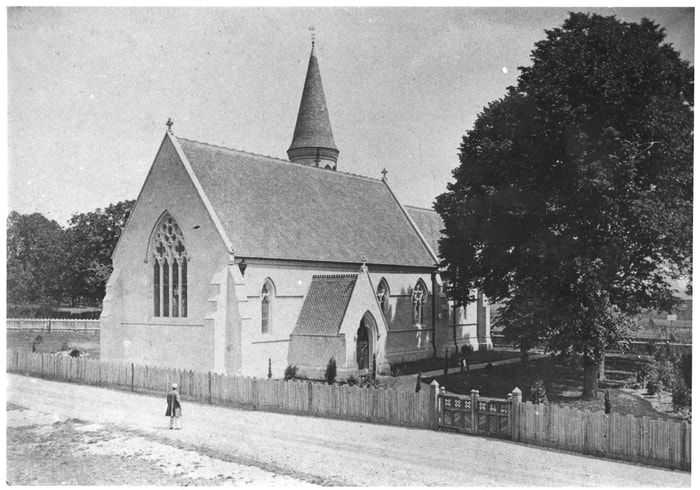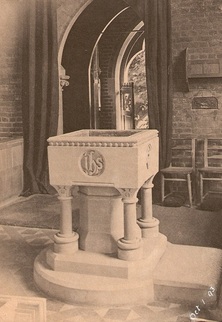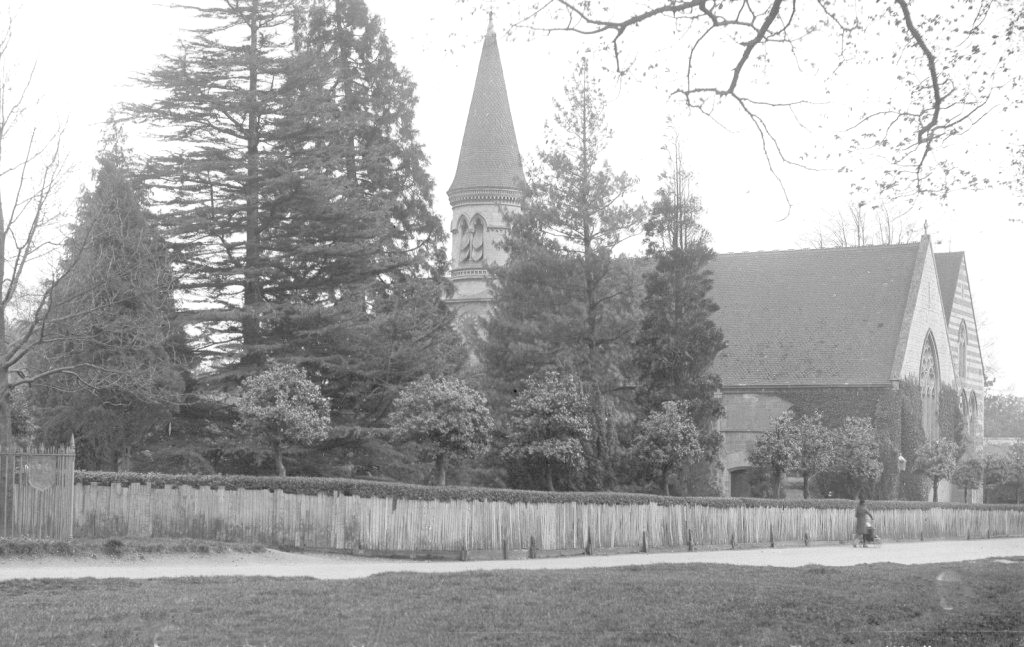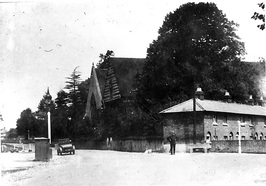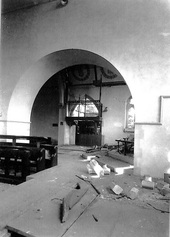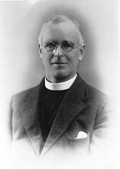All Saints Church - The Green
|
It was agreed to apply to the Master and Fellows of Gonville and Caius College, Cambridge, the Lords of the Manor of Croxley Green, for a building site. Many meetings followed and eventually it was agreed to build a church at the south end of the Green. The church commissioners paid the sum of six pounds for a triangular piece of land, so shaped by the turnpike road from Watford to Rickmansworth and the road to Sarratt.
Mr. John Norton architect of Old Bond Street, London was given the task of drawing up and preparing the initial plans for the Church with seating for 260 worshippers but not to include fencing for the site or for heating. The plans were approved and the contract for the building was given to Mr. Samuel Clarke of Bath for the sum of £2,318.3s.Od. It was intended that the Berean Cottages that stood in this area and would be in front of the new church were to be demolished, but in fact they remained until the late 1920's when they were replaced by the Parish Hall which opened in November 1932. |
|
At a ceremony On September 27th 1870 the foundation stone for the church was laid by the Right Hon. Lord Ebury. Temporary staging was decorated with evergreens and the vicar of St Mary’s Rickmansworth the Reverend A H Barker performed the service and the church choir was also present. Lord Ebury laid the stone and he was presented with a silver trowel suitably engraved. Records show that the cost of the building was collected by voluntary subscription. At this point £2,200 was collected plus a further amount of £33 on the day.
The architecture of the church was described as "Early English or first pointed Gothic." The dimensions in the plans showed the nave 63 feet long and 25 feet wide and 40 feet high and the chancel 30 feet long and 25 feet wide. A small tower surmounted by a spire was to be 83 feet high. The building works were completed by July 1871. This area of Hertfordshire did not have its own diocese and came under the Diocese of Rochester in Kent. Consequently it was the responsibility of the Bishop of Rochester to perform the act of consecration of the church. This took place on June 25th 1872 with the service conducted by, Thomas Legh Claughton, (When the Diocese of St. Albans was formed in 1877, Thomas Legh Claughton was appointed the first Bishop of St. Albans and the church then came under their administration) So many clergy attended the service that they had to robe in a cottage opposite the church. Following the service, Communion was celebrated, led by the Bishop. |
The Reverend. Astley Roberts M.A., curate of St Mary's, was appointed the first vicar of All Saints Church.
A Vestry Committee was formed and the first meeting took place on April l5th 1873 and continued to meet annually.
From the beginning the church became established as a focal part of the community and soon acquired a very impressive choir. It was a tradition at this time that the vicar involved himself in the running of the choir whilst local residents filled the other positions but William Southey living at Waterdell House, Little Green was charged with the roll of choir and organ master; William Barker living in 1 Flint Cottages opposite the Church was known to be the first organist whilst the first verger was Henry James
During this period, music was considered a pursuit enjoyed by the nobility and gentry. Their speech, intonation and enunciation lay down the way in which the singing was performed.
So when the working classes were encouraged to join they were set very high standards in music as well as in the English language. Ada Barker who lived in Briery Close voluntarily taught and trained new recruits for the choir.
Once the choir was formed they soon became established in singing the classics as well as church hymns. It would become customary for them to sing carols at Christmas time especially on Christmas Eve and St Stephens (Boxing Day) when they would be welcomed to perform inside the homes of the gentry around the village. As the parish boundary was very much larger then they would travel as far as Micklefield Hall (nr Sarratt) Redheath, Cassio House, Scotsbridge House, Glen Chess, (Loudwater) and Durrants House. As well as monetary donations made to the songsters the host at each venue regaled them with wine, beer and cake, a most welcome treat especially during these winter days. Boxing Day evening was set aside to sing in the church. Many considered their quality of singing to be equal to that of a cathedral choir.
When the Boys school opened in 1894 in the Watford Road, the new Headmaster, Alfred Walter Stratton-Hanes previously of Kings Lynn became the choir master. He came with a high reputation as a chamber and concert artiste.
From the beginning the church became established as a focal part of the community and soon acquired a very impressive choir. It was a tradition at this time that the vicar involved himself in the running of the choir whilst local residents filled the other positions but William Southey living at Waterdell House, Little Green was charged with the roll of choir and organ master; William Barker living in 1 Flint Cottages opposite the Church was known to be the first organist whilst the first verger was Henry James
During this period, music was considered a pursuit enjoyed by the nobility and gentry. Their speech, intonation and enunciation lay down the way in which the singing was performed.
So when the working classes were encouraged to join they were set very high standards in music as well as in the English language. Ada Barker who lived in Briery Close voluntarily taught and trained new recruits for the choir.
Once the choir was formed they soon became established in singing the classics as well as church hymns. It would become customary for them to sing carols at Christmas time especially on Christmas Eve and St Stephens (Boxing Day) when they would be welcomed to perform inside the homes of the gentry around the village. As the parish boundary was very much larger then they would travel as far as Micklefield Hall (nr Sarratt) Redheath, Cassio House, Scotsbridge House, Glen Chess, (Loudwater) and Durrants House. As well as monetary donations made to the songsters the host at each venue regaled them with wine, beer and cake, a most welcome treat especially during these winter days. Boxing Day evening was set aside to sing in the church. Many considered their quality of singing to be equal to that of a cathedral choir.
When the Boys school opened in 1894 in the Watford Road, the new Headmaster, Alfred Walter Stratton-Hanes previously of Kings Lynn became the choir master. He came with a high reputation as a chamber and concert artiste.
The choir would enjoy time away together and would sometimes join in with other local choirs on day trips to the seaside, involving a train ride and possibly a visit to Bournemouth, Folkestone or similar destinations.
Various church- based groups started to form and included a Church of England Men’s Society who had their own service in the church. The Church Lads Brigade formed a bugle band that played at their Church Parades, usually on the first Sunday in the month.
Various church- based groups started to form and included a Church of England Men’s Society who had their own service in the church. The Church Lads Brigade formed a bugle band that played at their Church Parades, usually on the first Sunday in the month.
 Waterdell House at Little Green and the pond
Waterdell House at Little Green and the pond
The church would receive requests for donations for the less well- off. A letter in 1905 from Great Ormond Street Hospital for Sick Children asks for the residents who have ‘fowls’ to be so good as to send fresh eggs to the hospital to improve the diet of the children. The costs of sending them would be defrayed and on application a supply of specially constructed boxes would be sent for their transportation by post or rail.
The two village schools at this time were influenced and administered by the church as well as other prominent people of Croxley Green. The schools were regularly visited by the vicar who monitored their knowledge of the Scriptures. Attendances at the church on national occasions during the year were an important part of village life for those who chose this form of worship.
With the steady growth of John Dickinson's paper mill, the local population increased and some 34yrs later the church had become very crowded and uncomfortable during the services, due to lack of facilities.
It became necessary to call a meeting in Waterdell House and on 20th September 1906, the vicar and churchwardens discussed plans for enlarging the church. Positive decisions were made and an agreement to proceed was made by the vicar, Revd. C.E.Donnell and churchwardens, Mr.C.Barton-Smith, Mr. E.Ormerod and some 50 members of the congregation. It was initially thought the sum of £2000 would be required and residents were asked to make donations, however large or small, to assist with these costs.
The two village schools at this time were influenced and administered by the church as well as other prominent people of Croxley Green. The schools were regularly visited by the vicar who monitored their knowledge of the Scriptures. Attendances at the church on national occasions during the year were an important part of village life for those who chose this form of worship.
With the steady growth of John Dickinson's paper mill, the local population increased and some 34yrs later the church had become very crowded and uncomfortable during the services, due to lack of facilities.
It became necessary to call a meeting in Waterdell House and on 20th September 1906, the vicar and churchwardens discussed plans for enlarging the church. Positive decisions were made and an agreement to proceed was made by the vicar, Revd. C.E.Donnell and churchwardens, Mr.C.Barton-Smith, Mr. E.Ormerod and some 50 members of the congregation. It was initially thought the sum of £2000 would be required and residents were asked to make donations, however large or small, to assist with these costs.
 Work on the extension 1907
Work on the extension 1907
Mr. Temple-Moore, an architect from London, was approached to produce a suitable design. He submitted three plans in April 1907 including one of which was to duplicate the present church building and build an identical one on the south side. This was accepted as the best option for economic reasons. However, each half was to be on a different level as this would keep the costs down to about £3,000 or under if possible.
A further appeal was launched to raise the monies required and S. Sherwin builders of Boston Lincolnshire was given the contract to build the extension commencing work in October 1907.
During the build many alterations were made to the specification and they were able to reduce the cost to £2,788.
Whilst work was under way, services were held in the Girls' school in Yorke Road.
On completion, the new nave was furnished with 200 chairs supplied by Messrs Joynson & Holland & Company of Abercrombie Works, High Wycombe at 3/10d each. They were fitted with wooden pegs to hold the hassocks instead of hooks preventing the possibility that ladies might snag their dresses on the hooks.
The final cost would appear to have been approximately £3,198. The new nave and chancel were consecrated on Saturday, May 23rd 1908, by the Right Revd. Frank Johnson, Bishop of Colchester.
A further appeal was launched to raise the monies required and S. Sherwin builders of Boston Lincolnshire was given the contract to build the extension commencing work in October 1907.
During the build many alterations were made to the specification and they were able to reduce the cost to £2,788.
Whilst work was under way, services were held in the Girls' school in Yorke Road.
On completion, the new nave was furnished with 200 chairs supplied by Messrs Joynson & Holland & Company of Abercrombie Works, High Wycombe at 3/10d each. They were fitted with wooden pegs to hold the hassocks instead of hooks preventing the possibility that ladies might snag their dresses on the hooks.
The final cost would appear to have been approximately £3,198. The new nave and chancel were consecrated on Saturday, May 23rd 1908, by the Right Revd. Frank Johnson, Bishop of Colchester.
On September 23rd 1913, it was agreed at a meeting that steps be taken to put this in motion and the first meeting took place on June 25th 1914, the forty second anniversary of the church and five years before it became a legal obligation in 1919. The new council was to have wider powers of administration in the running of the church and its finances.
It was during this time that the parish once again experienced quite dramatic times as the First World War had its impact on its community. Young men who had gone off to fight against the German invasion of lands in Europe failed to return. The war finally ended in November 1918.
A tradition of planting oak trees on The Green to celebrate major events had started in the reign of Queen Victoria. Accordingly it was decided to commemorate the war dead. HT Wilson -‘Neggy’ (Headmaster of the boys’ school) along with other residents selected a suitable oak tree from Berkhamstead. The villagers raised the money for the tree by purchasing special little lapel button badges. The tree was blessed at a special service in All Saints church and then carried to the designated site on The Green, opposite New Road.. On Sunday afternoon 2nd November 1919 the tree was duly planted by ex service men. Large granite blocks were obtained from the John Dickinson mill and placed together in front of the tree with the names of those who had lost their lives. Protective railings with a gate were erected to deter passing cattle from damaging the young tree. At this time cows were still being herded daily from the fields near the Sarratt Road to a milking parlour on Scots Hill.
A memorial service was held the following and subsequent years on 11th November 1920
A memorial board was also erected inside the church recording the details of those who fought in the war.
It was during this time that the parish once again experienced quite dramatic times as the First World War had its impact on its community. Young men who had gone off to fight against the German invasion of lands in Europe failed to return. The war finally ended in November 1918.
A tradition of planting oak trees on The Green to celebrate major events had started in the reign of Queen Victoria. Accordingly it was decided to commemorate the war dead. HT Wilson -‘Neggy’ (Headmaster of the boys’ school) along with other residents selected a suitable oak tree from Berkhamstead. The villagers raised the money for the tree by purchasing special little lapel button badges. The tree was blessed at a special service in All Saints church and then carried to the designated site on The Green, opposite New Road.. On Sunday afternoon 2nd November 1919 the tree was duly planted by ex service men. Large granite blocks were obtained from the John Dickinson mill and placed together in front of the tree with the names of those who had lost their lives. Protective railings with a gate were erected to deter passing cattle from damaging the young tree. At this time cows were still being herded daily from the fields near the Sarratt Road to a milking parlour on Scots Hill.
A memorial service was held the following and subsequent years on 11th November 1920
A memorial board was also erected inside the church recording the details of those who fought in the war.
It was soon after this in 1922 when the church celebrated 50 years since it was first consecrated with celebrations in the vicarage gardens.
Many residents from Croxley Green and surrounding areas who were employed at John Dickinson mill had enlisted to support the war. It was agreed that the company should recognise the casualties and they did this by a remembrance garden on the mill site.
The chosen site for the memorial garden was at the main Watford entrance to the mill and a Celtic cross was positioned on a turf bank faced with rough stone. It was also agreed the bronze tablet/plaque originally fitted in the Institute should be remounted in a block behind the Memorial Cross. This plaque contains the names all the casualties from the individual mills and offices who lost their lives.
A large gathering of Croxley employees and representatives from Apsley mill (one of several mills John Dickinson also owned) assembled for the memorial ceremony on December 8th 1922, as well as family members of those who had lost their lives.. The Rev C.H. Blois Bisshopp Vicar of All Saints Church, Mr. R.H. Ling, Managing Director, Mr. M Skeins, Manager of Croxley Mill and Mr. Charles Barton – Smith, retired manager were also present. Ex Service men too attended also representing various departments
The chosen site for the memorial garden was at the main Watford entrance to the mill and a Celtic cross was positioned on a turf bank faced with rough stone. It was also agreed the bronze tablet/plaque originally fitted in the Institute should be remounted in a block behind the Memorial Cross. This plaque contains the names all the casualties from the individual mills and offices who lost their lives.
A large gathering of Croxley employees and representatives from Apsley mill (one of several mills John Dickinson also owned) assembled for the memorial ceremony on December 8th 1922, as well as family members of those who had lost their lives.. The Rev C.H. Blois Bisshopp Vicar of All Saints Church, Mr. R.H. Ling, Managing Director, Mr. M Skeins, Manager of Croxley Mill and Mr. Charles Barton – Smith, retired manager were also present. Ex Service men too attended also representing various departments
On the land in front of the church 10 cottages known as the Berean Cottages were now in need of modernisation but this was considered not a viable project because of their original design.
They had originally been built at the beginning of the 19th century by Miss Mary Bentley who lived in a large country house, Bathhannah Pavilion on The Green. Many years later when a Miss Dugdale resided there she changed the name to The Grove. Miss Bentley also built Waterdell at Little Green.
The Berean cottages, originally built and intended for alms houses, were sold by Mr. W R Woolrych living at Croxley House (a relation of Miss Bentley) to Mr. Woods (of Durrants House) in 1876c. The cottages and their tenants were then thought to be a nuisance.
However, even though they were not up to standard, in the ensuing years they were welcome as temporary accommodation for soldiers returning from the First World War. A nominal rent of 1d a week had been decided upon and the local people soon referred to the cottages as Penny Row or Heroes Terrace.
In 1920 when the cottages were now owned by Charles Morland Agnew of Durrants House they were presented to the church as a site for a new Parish Hall. However, it was to take many years for the plan to come to fruition.
Eventually, plans were made and accepted and the cottages were demolished by the Watford Sand and Ballast Company and a new and welcome church hall was opened in November 1932 by the Arch Deacon of St Albans. When the cottages were demolished the plaque ‘Berean Cottages 1827’ was removed and re-sited in the wall of a builder’s yard opposite the church.
They had originally been built at the beginning of the 19th century by Miss Mary Bentley who lived in a large country house, Bathhannah Pavilion on The Green. Many years later when a Miss Dugdale resided there she changed the name to The Grove. Miss Bentley also built Waterdell at Little Green.
The Berean cottages, originally built and intended for alms houses, were sold by Mr. W R Woolrych living at Croxley House (a relation of Miss Bentley) to Mr. Woods (of Durrants House) in 1876c. The cottages and their tenants were then thought to be a nuisance.
However, even though they were not up to standard, in the ensuing years they were welcome as temporary accommodation for soldiers returning from the First World War. A nominal rent of 1d a week had been decided upon and the local people soon referred to the cottages as Penny Row or Heroes Terrace.
In 1920 when the cottages were now owned by Charles Morland Agnew of Durrants House they were presented to the church as a site for a new Parish Hall. However, it was to take many years for the plan to come to fruition.
Eventually, plans were made and accepted and the cottages were demolished by the Watford Sand and Ballast Company and a new and welcome church hall was opened in November 1932 by the Arch Deacon of St Albans. When the cottages were demolished the plaque ‘Berean Cottages 1827’ was removed and re-sited in the wall of a builder’s yard opposite the church.
It was during this period that the parish church was under an enormous strain accommodating all the new residents from the huge housing development that was in progress. The current vicar Rev. Percy Langdon discussed plans with the St Albans Diocesan to create a second parish hall within the village and this was agreed. The Parish of St Oswald in Malvern Way was set up and a new hall built in 1937. Subsequently in years to come again because of village growth, St Oswald obtained its own ecclesiastical district in 1946 and a separate church was built in 1962.
The life of the church had continued through the years of depression, the General Strike, the abdication of Edward VIII, coronation of George VI until World War Two.
Whilst Germany was continuing to invade countries in Europe, Britain was putting together plans to secure the safety of its people. Hitler appeared unstoppable and efforts by the British Prime Minister to bring about peace were ignored.
Schools in London drew up a strategy to evacuate the school children and their teachers to safer parts of Britain. Croxley Green was one of the many chosen initially, as it was considered ‘countryside’ and safe and still within easy reach of London for the children’s return if required.
Different locations in the village were identified for these schools to operate whilst the children and their teachers were housed with local residents. The School of St Sepulchre’s Church, Holborn moved into All Saints’ Hall for their lessons.
However, Croxley Green was not to escape the German attacks and on September 25th 1940 at 9.35pm the east end of the church was severely damaged by a parachute mine; the tower, roof, organ, pulpit and the Lady Chapel all suffered serious damage.
The life of the church had continued through the years of depression, the General Strike, the abdication of Edward VIII, coronation of George VI until World War Two.
Whilst Germany was continuing to invade countries in Europe, Britain was putting together plans to secure the safety of its people. Hitler appeared unstoppable and efforts by the British Prime Minister to bring about peace were ignored.
Schools in London drew up a strategy to evacuate the school children and their teachers to safer parts of Britain. Croxley Green was one of the many chosen initially, as it was considered ‘countryside’ and safe and still within easy reach of London for the children’s return if required.
Different locations in the village were identified for these schools to operate whilst the children and their teachers were housed with local residents. The School of St Sepulchre’s Church, Holborn moved into All Saints’ Hall for their lessons.
However, Croxley Green was not to escape the German attacks and on September 25th 1940 at 9.35pm the east end of the church was severely damaged by a parachute mine; the tower, roof, organ, pulpit and the Lady Chapel all suffered serious damage.
The damage was estimated at £13,000 excluding that done to the organ and boiler. Temporary repairs took nearly a year, during which time services were held in the church hall. Because of constant delays in obtaining the money from the War Damages Commission, it was nearly the end of 1952 before the church was fully restored and was hallowed by the Lord Bishop of St Albans on Sunday January 18th 1953.
During the demolition of the John Dickinson paper mill in the 1980’s as the whole site was being cleared the Royal British Legion salvaged the bronze memorial tablet and a marble Celtic cross. After lengthy discussions with All Saints Church the tablet was fixed to the south wall of the church and an area was made available in front as a ‘Garden of Remembrance’ A re-dedication service took place on Remembrance Sunday November 1985.
The marble cross was in fact a replacement as the original suffered damage when it was removed and stored during a time when John Dickinson had expanded the mill. The grounds of the church did not allow for the replacement Celtic cross to be included and it was accepted at the time by a resident for safe keeping.
In October 2012 the church was served with a noise abatement notice by Three Rivers District Council against the sounding of the chimes, which strike the hours during the night, following a resident’s complaint. As the church had no mechanism to control the striking of the 140-year-old chimes, it was forced to stop them completely. Many people were angered by the serving of the notice and wanted the chimes restored. However, in 2013 mechanism was installed that allowed the clock chimes to function but to cease after 10pm and restart at 7am.
All Saints Church and its church hall is always in great demand for all manner of activities for the residents of Croxley Green and remains a presence on one of the three main entrances into the parish.
Since gaining its own parish and parish church each vicar of All Saints has supported the growth of the village from several hundred parishioners to several thousand.
The current All Saints website can be found here www.croxleygreenallsaints.org
The marble cross was in fact a replacement as the original suffered damage when it was removed and stored during a time when John Dickinson had expanded the mill. The grounds of the church did not allow for the replacement Celtic cross to be included and it was accepted at the time by a resident for safe keeping.
In October 2012 the church was served with a noise abatement notice by Three Rivers District Council against the sounding of the chimes, which strike the hours during the night, following a resident’s complaint. As the church had no mechanism to control the striking of the 140-year-old chimes, it was forced to stop them completely. Many people were angered by the serving of the notice and wanted the chimes restored. However, in 2013 mechanism was installed that allowed the clock chimes to function but to cease after 10pm and restart at 7am.
All Saints Church and its church hall is always in great demand for all manner of activities for the residents of Croxley Green and remains a presence on one of the three main entrances into the parish.
Since gaining its own parish and parish church each vicar of All Saints has supported the growth of the village from several hundred parishioners to several thousand.
The current All Saints website can be found here www.croxleygreenallsaints.org
The following are the names and times they have served the Croxley Green community.
|
Rev Astley Roberts
Rev Charles E H Donnell Rev Edward Wells Rev Charles H Blois-Bisshopp Rev Percy G Langdon Rev Gordon B Ince Rev Arthur C E Suffrin Rev Alfred S Conway Rev Malcolm C King Rev Luke G H Lee Rev Miriam Mugan |
1872-1899
1899-1913 1913-1916 1917- 1933 1933- 1947 1947- 1953 1953- 1963 1963- 1981 1981- 1990 1990- 2007 2007- |


